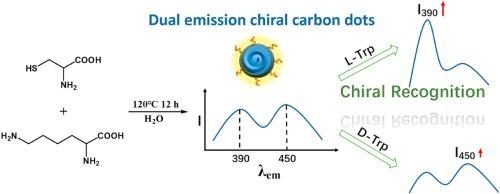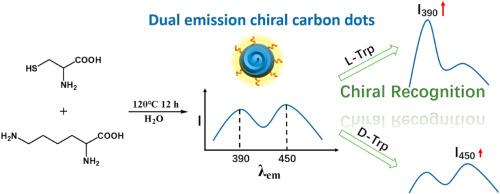Dual emission chiral carbon dots as fluorescent probe for fast chiral recognition of tryptophan enantiomers
IF 5.7
2区 化学
Q1 CHEMISTRY, ANALYTICAL
引用次数: 0
Abstract
Background
Chirality is an essential property of nature. Chiral recognition is of great significance to life sciences, pharmaceutical industry, food analysis, and so on. Chiral carbon dots (CCDs), as green nanomaterials, have great prospects in chiral sensing. However, CCDs with enantioselectivity for tryptophan (Trp) enantiomers are scarce. Moreover, most chiral sensing platforms depend on the difference of fluorescence intensity at the same emission wavelength to identify enantiomers, it is still a challenge to distinguish enantiomers by the positions of fluorescent emission peaks.
Results
Novel CCDs with specific chiral recognition ability for Trp enantiomers are synthesized using l-lysine and l-cysteine as precursors. The CCDs have two fluorescent emission peaks at 390 nm and 450 nm. Interestingly, the fluorescence intensity of CCDs at 390 nm enhances obviously on the addition of L-Trp, while it enhances slightly at 450 nm in the presence of D-Trp. This chiral sensing system not only can identify Trp enantiomers according to fluorescence intensity, but also achieves the distinguishment depending on emission wavelength. The enantioselectivity (IL/ID) reaches 4.5 when the concentration of Trp enantiomer is 1 mM. This chiral sensing platform not only can be used for quantitative analysis of D-Trp and L-Trp, but also can be used for determining the enantiomeric excess of racemates. The chiral recognition mechanism is investigated by molecular simulation. It is found that L-Trp has higher binding energy with CCDs.
Significance
This work presents a novel kind of CCDs with special chiral recognition performance for Trp enantiomers, and opens the door to identify chiral isomers according to wavelength difference, which has profound significance for the development of chiral sensing platforms, and may provide inspirations for the design of novel CCDs with excellent chiral recognition performance.


双发射手性碳点作为快速手性识别色氨酸对映体的荧光探针
背景手性是自然界的基本属性。手性识别在生命科学、制药工业、食品分析等领域具有重要意义。手性碳点(CCD)作为一种绿色纳米材料,在手性传感方面具有广阔的前景。然而,对色氨酸(Trp)对映体具有对映选择性的 CCD 还很少见。结果以 L-赖氨酸和 L-半胱氨酸为前体,合成了对 Trp 对映体具有特定手性识别能力的新型 CCD。CCD 在 390 nm 和 450 nm 处有两个荧光发射峰。有趣的是,加入 L-Trp 后,CCD 在 390 纳米波长处的荧光强度明显增强,而加入 D-Trp 后,CCD 在 450 纳米波长处的荧光强度略有增强。这种手性传感系统不仅能根据荧光强度识别 Trp 对映体,还能根据发射波长进行区分。当 Trp 对映体的浓度为 1 mM 时,其对映体选择性(IL/ID)达到 4.5。这种手性传感平台不仅可用于定量分析 D-Trp 和 L-Trp,还可用于确定外消旋体的对映体过量。通过分子模拟研究了手性识别机制。意义 本研究提出了一种新型的对 Trp 对映体具有特殊手性识别性能的 CCD,为根据波长差识别手性异构体打开了一扇大门,对手性传感平台的开发具有深远意义,并可为设计具有优异手性识别性能的新型 CCD 提供启示。
本文章由计算机程序翻译,如有差异,请以英文原文为准。
求助全文
约1分钟内获得全文
求助全文
来源期刊

Analytica Chimica Acta
化学-分析化学
CiteScore
10.40
自引率
6.50%
发文量
1081
审稿时长
38 days
期刊介绍:
Analytica Chimica Acta has an open access mirror journal Analytica Chimica Acta: X, sharing the same aims and scope, editorial team, submission system and rigorous peer review.
Analytica Chimica Acta provides a forum for the rapid publication of original research, and critical, comprehensive reviews dealing with all aspects of fundamental and applied modern analytical chemistry. The journal welcomes the submission of research papers which report studies concerning the development of new and significant analytical methodologies. In determining the suitability of submitted articles for publication, particular scrutiny will be placed on the degree of novelty and impact of the research and the extent to which it adds to the existing body of knowledge in analytical chemistry.
 求助内容:
求助内容: 应助结果提醒方式:
应助结果提醒方式:


